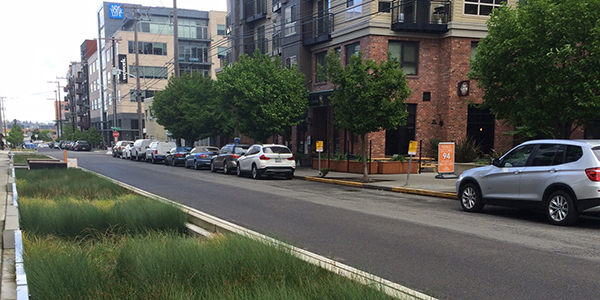Photo credit: Seattle Public Utilities
When land is being torn up anyway, there are often opportunities for managing runoff with green infrastructure.
Regulating new development and redevelopment projects to manage stormwater on site is becoming the norm in many cities. However, in most cities, development and redevelopment is only a small portion of the land area. In order to meet water quality and flood protection goals, municipalities are getting creative with finding opportunities to manage stormwater.
Seattle provides one great example. When a major redevelopment was planned for Yale Avenue, the developer would ordinarily have been required to manage the runoff from the impervious area on the site. But Seattle Public Utilities saw an even greater opportunity – to manage polluted runoff from over 400 acres of impervious surface that flowed nearby through an underground stormwater pipe and discharged to an urban lake.
This runoff was not the responsibility of the developer, however he cooperated with the utility to combine the project with the installation of four blocks of bioswales in the rights of way which would treat stormwater coming from the larger impervious area. The “Swale on Yale”, the first stage of which was completed in 2013 (the entire project will be finished by 2017) will treat 190 million gallons of stormwater annually.
Like many U.S. cities, Seattle needs to improve its stormwater and combined sewer systems to comply with permits from the USEPA. Seattle Public Utilities, via drainage fees collected from property owners, funds projects which reduce polluted runoff entering Seattle’s receiving water bodies, as part of staying in compliance.
But even without regulation, the investment makes sense, says Pam Emerson, Green Infrastructure Advisor with the City of Seattle. “With one investment in green infrastructure, you add greenery to urban corridors, improve pedestrian safety, improve air quality and manage polluted runoff.”
Following the success of isolated green infrastructure projects across the city, Seattle City Council directed a number of city departments, in 2013, to work together to manage 700 million gallons of stormwater runoff annually using green infrastructure by 2025. The Seattle green infrastructure implementation strategy, released in July 2015, identifies interim targets and strategies that will be used to achieve them. The city is on track to meet its target of 400 million gallons annually by 2020.
Seattle’s reputation as a rainy city may not be well-deserved (it doesn’t even make the list of the top 15 U.S. cities in terms of total precipitation, though it does rank #6 in the country for the number of rainy days annually). However, it’s certainly a leader in the way it manages its rainfall.
This article was published in The Umbrella Stormwater Bulletin Issue #34
Poll
What drives/would drive the adoption of green infrastructure in your city? (select all that apply)
- Climate adaptation (11%, 2 Votes)
- Lower cost (17%, 3 Votes)
- Regulation (17%, 3 Votes)
- Water quality (33%, 6 Votes)
- City beautification (17%, 3 Votes)
- Other (6%, 1 Votes)
Total Voters: 7


